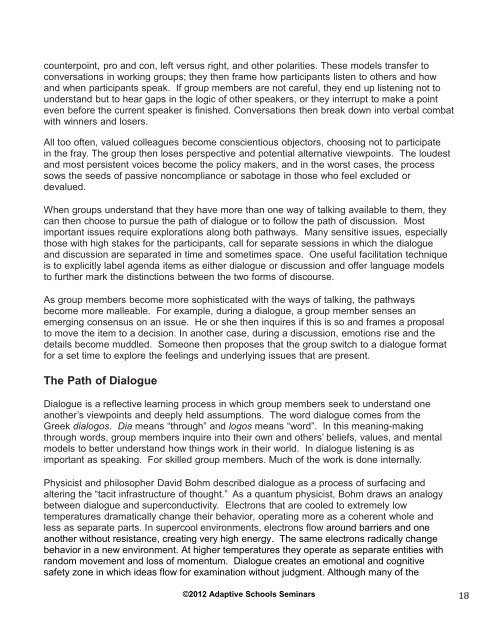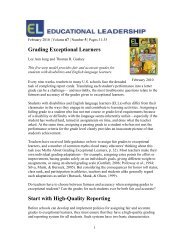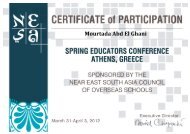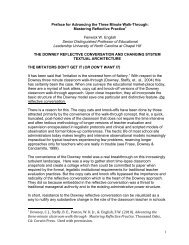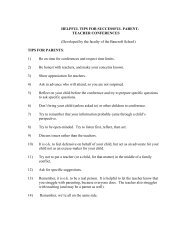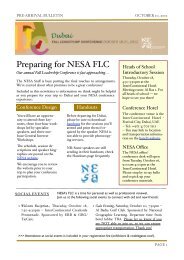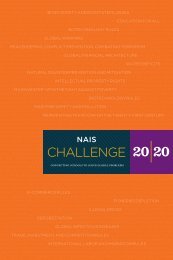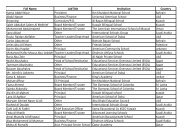Facilitation Skills for Teacher Leaders Handout - NESA
Facilitation Skills for Teacher Leaders Handout - NESA
Facilitation Skills for Teacher Leaders Handout - NESA
Create successful ePaper yourself
Turn your PDF publications into a flip-book with our unique Google optimized e-Paper software.
counterpoint, pro and con, left versus right, and other polarities. These models transfer toconversations in working groups; they then frame how participants listen to others and howand when participants speak. If group members are not careful, they end up listening not tounderstand but to hear gaps in the logic of other speakers, or they interrupt to make a pointeven be<strong>for</strong>e the current speaker is finished. Conversations then break down into verbal combatwith winners and losers.All too often, valued colleagues become conscientious objectors, choosing not to participatein the fray. The group then loses perspective and potential alternative viewpoints. The loudestand most persistent voices become the policy makers, and in the worst cases, the processsows the seeds of passive noncompliance or sabotage in those who feel excluded ordevalued.When groups understand that they have more than one way of talking available to them, theycan then choose to pursue the path of dialogue or to follow the path of discussion. Mostimportant issues require explorations along both pathways. Many sensitive issues, especiallythose with high stakes <strong>for</strong> the participants, call <strong>for</strong> separate sessions in which the dialogueand discussion are separated in time and sometimes space. One useful facilitation techniqueis to explicitly label agenda items as either dialogue or discussion and offer language modelsto further mark the distinctions between the two <strong>for</strong>ms of discourse.As group members become more sophisticated with the ways of talking, the pathwaysbecome more malleable. For example, during a dialogue, a group member senses anemerging consensus on an issue. He or she then inquires if this is so and frames a proposalto move the item to a decision. In another case, during a discussion, emotions rise and thedetails become muddled. Someone then proposes that the group switch to a dialogue <strong>for</strong>mat<strong>for</strong> a set time to explore the feelings and underlying issues that are present.The Path of DialogueDialogue is a reflective learning process in which group members seek to understand oneanother’s viewpoints and deeply held assumptions. The word dialogue comes from theGreek dialogos. Dia means “through” and logos means “word”. In this meaning-makingthrough words, group members inquire into their own and others’ beliefs, values, and mentalmodels to better understand how things work in their world. In dialogue listening is asimportant as speaking. For skilled group members. Much of the work is done internally.Physicist and philosopher David Bohm described dialogue as a process of surfacing andaltering the “tacit infrastructure of thought.” As a quantum physicist, Bohm draws an analogybetween dialogue and superconductivity. Electrons that are cooled to extremely lowtemperatures dramatically change their behavior, operating more as a coherent whole andless as separate parts. In supercool environments, electrons flow around barriers and oneanother without resistance, creating very high energy. The same electrons radically changebehavior in a new environment. At higher temperatures they operate as separate entities withrandom movement and loss of momentum. Dialogue creates an emotional and cognitivesafety zone in which ideas flow <strong>for</strong> examination without judgment. Although many of the©2012 Adaptive Schools Seminars 18


